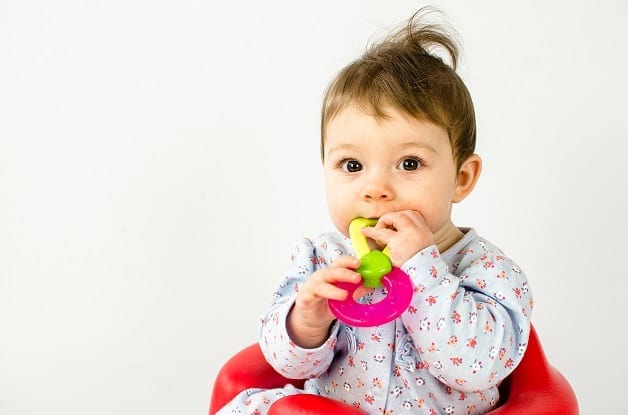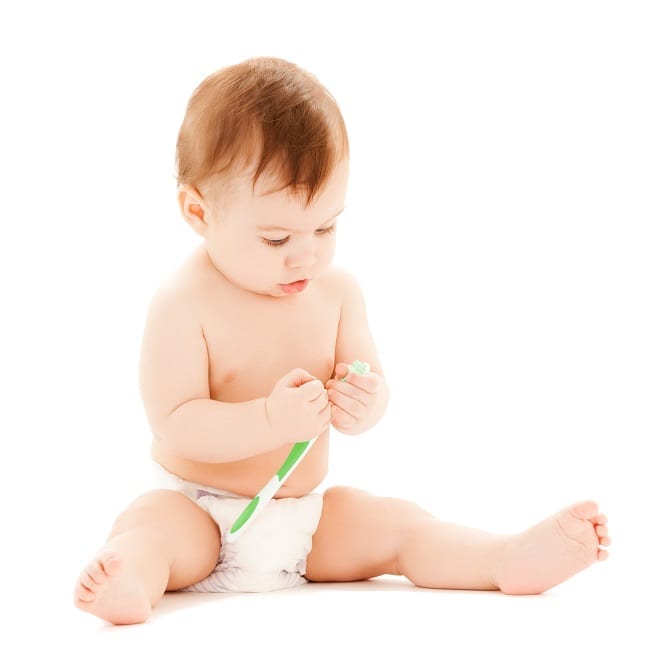Imagine your baby is smiling. Look at his lower gum. Are his pearly whites starting to make an appearance? If so, your baby is teething. Actually, teething begins when your baby is still inside the womb. During pregnancy, the baby starts to develop tooth buds, which are known to be the foundation of baby teeth.
Healthy baby teeth – also called primary teeth, deciduous teeth, or milk teeth – aid in proper speech development, allow your baby to enjoy a healthy diet when he is ready to eat, improve his digestion, and enhance a child’s appearance. All of these will give confidence to your child as he gets older. Growing good teeth is obviously important for any child, that’s why risk factors in your baby’s dental health (which include a family history of cavities as well as a mother’s poor dental health during pregnancy) should be considered.
When to Expect Teething of Babies
According to Jeffrey Bourne, a pediatrician from Providence Saint John’s Health Center in California, your baby’s teething occurs between six (6) to 13 months. Although it can happen as early as four (4) months, this is actually very rare. When a baby is born, it is also possible for him to have teeth already but again, this is not very common.
None of us probably remember our own teething experience, but the reality is that it really hurts when teeth start poking up through the gums. When this starts happening, you can definitely tell that your baby feels very uncomfortable. Babies prefer to feel pressure on their gums to distract their brains from the pain caused by teething. The American Dental Association (ADA) recommends seeing a dentist as soon as the first tooth of the baby erupts.
The Classic Teething Symptoms

You will know that your baby is teething through several signs. Teething can cause lots of fussiness or irritation to your baby – so expect lots of crying and sleepless nights (more than the usual sleeplessness due to round-the-clock feedings). Be patient with your baby as the teething process really hurts. Get the baby’s attention by giving him car rides, cuddling or playing with him, telling him stories, singing to him, and doing other relaxing things together.
Expect that your baby will drool a lot. The simple reason for this is that teething stimulates saliva production, so make sure you prepare a bib or any other soft cloth for easy wiping. Other signs of teething are swollen and sensitive gums, gnawing or chewing behavior, the baby’s refusal to eat due to lack of appetite, flushed cheeks, pulling on the ear, trouble sleeping, and a low-grade rectal fever of around 37.2 Celsius (98.96 Fahrenheit).
Teething also typically comes with fever, diarrhea, runny nose, and other symptoms, but teething does not actually cause those conditions. Instead, babies may develop viral illnesses while teething. To be on the safe side, always keep your child’s pediatrician updated about his health status.
The Teething Order and Timelines
Your baby’s tooth may come one (1) at a time or two (2) at once. The teeth usually do not come in straight but they eventually will.
What is the order that your baby’s teeth will come in? The baby’s teeth appearance may vary but here is the common arrangement:
- The bottom middle teeth or the lower central incisors come in between four (4) to seven (7) months. These two (2) teeth usually appear at the same time.
- The upper middle teeth or the upper central incisors usually emerge between eight (8) to 12 months. Girls usually get their teeth earlier than boys of the same age.
- Around nine (9) to 13 months, the baby’s upper lateral incisors start to show.
- In ten (10) to 16 months, lower lateral incisors appear. These are the lower teeth to the right and left of center.
- Your baby’s first molars are the upper molars. They are the wider teeth toward the back of the mouth. These erupt between 13 to 19 months. The first molars appear in the bottom and the top at the same time.
- The lower first molars become visible by around 14 to 18 months.
- The upper canines or the upper cuspids fill the gap between incisors and first molars. These can be seen during 16 to 22 months. These teeth are also called as dog teeth.
- The lower canines or the lower cuspids start to appear at around 17 to 23 months.
- The upper second molars become visible at around 25 to 33 months.
- By three (3) years of age, your child is likely to have a full set of 20 baby teeth.
- Notice that as your child’s jaw and facial bones grow, there will be spaces created between the baby teeth. Do not be bothered by these spaces, as they are meant for the child’s permanent teeth.
- By the age of six (6), your child will start to lose his baby teeth.
- Your child’s set of permanent teeth or adult teeth may be completed between the ages of 17 to 21.
While the above timeline is typical, keep in mind that there is much variation in the teething timelines of different children, which is due to several factors such as heredity. The important thing to remember is this: if by the 18th month your child still has no teeth, you must definitely alert his pediatrician and/or pediatric dentist.
How to Help Your Baby During Teething

While discomfort during the teething phase is normal, there are some pediatrician-approved teething remedies that can help your child get through this painful stage of his early life. Here are some of them:
- Chewing or eating on something cold. Applying something cold can help relieve any swelling and pain in an instant as it numbs the pain receptors in the affected area. You can put a small clean soft cloth soaked in a chamomile tea inside your fridge and use it as your baby’s gnawing material after some time. Chamomile is proven to have extra smoothing touch, which can help your baby calm down. You can also try frozen pacifier, frozen baby spoon, teething toys, and teething rings. Cold carrot, frozen waffle, cold cut up cucumber slices, frozen cheese sticks, cold celery, cold pickle, cold yogurt, frozen fruits, and frozen breast milk can also be your alternatives especially when your baby loves to eat already. Keep an eye on your baby as eating might pose a choking hazard.
- Babies who are six (6) months and older, it is safe to use painkillers like acetaminophen or ibuprofen. Note that ibuprofen helps in reducing gum inflammation but may affect your baby’s tummy making him refuse to eat. It is suggested to give painkillers at bedtime. This will help in giving you and your baby a good sleep. Check for the appropriate dosage for your baby’s weight. Do not forget to consult your doctor before giving any painkillers to your baby.
- Always dry the drool to prevent skin irritation by keeping a clean cloth on your baby’s chin.
- Massage or rub your baby’s gum using your clean pinky finger or moistened gauze pad.
Try whichever works for your baby. You can think of your own as long as safety is ensured.
Meanwhile, you should AVOID doing or using the following:
- Teething gels with benzocaine are unsafe topical numbing cream. In May 2018, the Food and Drug Administration (FDA) of the United States discourages parents to use teething gels with benzocaine for children below two (2) years old unless recommended by a doctor. Benzocaine can cause methemoglobinemia. It’s a blood disorder in which an abnormal amount of methemoglobin is produced, thus leading to a very low amount of oxygen in the blood. This is a serious condition that can cause death. The common signs are pale, gray-, or blue-colored skin, lips, and nail beds, fatigue, rapid heart rate, and difficulty in breathing.
- Amber necklaces contain succinic acid that is believed to be anti-inflammatory, immune boosting, antioxidant rich, and calming and soothing. According to the US FDA, succinic acid is safe. In fact, it is often added to ingestible products. This can minimize the pain that your baby will feel. Doctors warn parents that without close supervision, the beads of the necklace are a choking hazard when break.
- Homeopathic teething tablets contain belladonna. It is an herb used as a painkiller. It is reported that belladonna can be toxic. US FDA advised parents to refuse from using homeopathic teething tablets, as there are recorded incidents that babies and toddlers experience seizures, muscle weakness, lethargy, excessive sleepiness, and agitation after taking them. There was a report in September 2017 from the Center for Disease Control about an infant who suffered from lead poisoning after chewing a bracelet. The said bracelet was a homeopathic magnetic hematite health bracelet that would help ease the pain caused by teething.
- Do not give your baby aspirin. It can lead to Reye’s syndrome, a rare condition that causes swelling in the brain and liver. The symptoms are confusion and seizures.
Make sure to keep an eye on your baby to avoid instances like choking. At the end of the day, your baby’s safety should be your top priority.
Never Too Early to Clean Your Baby’s First Teeth

Actually, gums should also be cleaned even without your baby’s first tooth yet. Use a soft wet cloth in wiping your baby’s gums during bath time. Why is cleaning needed this early? You do not know exactly when the first tooth will come out. Bacteria are already in your baby’s mouth. This is a practice of making sure that the bacteria are lessened or prevented as the tooth shows up! Cleansing can also prevent bacteria from building up in your baby’s mouth.
Do we need to use toothpaste in cleaning the baby’s first teeth? Once your baby’s teeth appear, you can easily clean them by wiping using a clean cloth or brushing with a baby toothbrush twice a day. Toothpaste is not yet needed. For your baby to enjoy brushing, you may use fluoride-free toothpaste. It is safe to swallow.
Though baby teeth soon will all fall out, tooth decay should still be prevented because the decays will leave gaps on the areas where the permanent teeth will come out creating gaps and will easily get crooked.
Remember that when you care for your baby’s teeth, you are already setting him up for good long-term dental health.
Why Is There a Need for Fluoride?
We know that fluoride helps prevent tooth decay by strengthening the enamel so it can fight against the acids in your baby’s mouth and harmful bacteria. Your baby, when he reaches his 6th month, will need just a few amounts of fluoride as too much can lead to a condition called fluorosis. This condition causes white spots that will only show up when your child had his adult teeth. Fluoride is available on the drinking water. If the fluoride content of the water is not enough, your child will need fluoride supplement.
In general, it is not good to give your baby water until he is six (6) months old. Breast milk or formula can take care of your baby’s hydration. Keep in mind that taking care of your baby’s teeth in his early years is the first step in achieving a lifetime healthy teeth and gums.
How to Take Care of Your Baby’s Teeth?
- It is important to keep our baby’s teeth clean. As soon as the teeth become visible, brush them twice a day in a gentle manner. Use a baby toothbrush and a smear of toothpaste. When your baby reached two (2) years old, you may now use toothpaste for your baby. Make sure to limit it at pea-size. To reach all tooth surfaces, use colorful flossing sticks to get the attention of your child. At about 18 months, a child can normally brush his teeth on his own. Let your toddler watch you do the brushing. Do not forget to replace the toothbrush when you notice that the bristles look splayed.
- Do not let your baby go to sleep with a bottle unless it contains water. The milk formula and breast milk both contain sugar that can cause tooth decay. When your baby reaches his first year, use a cup (not a sippy one) instead of a baby bottle. This also lowers chances of tooth decay.
- When your baby reaches six (6) months, it is recommended to have him check by his doctor. It is the best time to know if he is already allowed to take fluoride supplement. Fluoride prevents cavities.
- Do not give too many sweets, as these are known to damage the teeth and enamel, both of children and adults.
The more that you know and help your child with his teething, the more you can help your baby grow into a healthy and confident person.
Thantakit International Dental Center is Thailand’s longest established dental center. Its dentists have an extensive experience in providing high-quality dental treatments to patients of all ages. Thantakit is renowned across the world as a destination for world-class dentistry, with many patients flying in from Australia. Get in touch with us today and get a FREE dental consultation!












